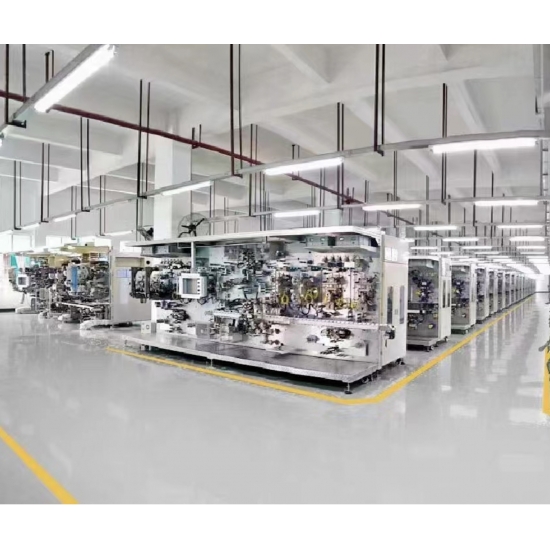Pouch Cell Manufacturing Plant: Processes, Equipment, and Applications
A pouch cell manufacturing plant is a specialized facility dedicated to producing pouch-type lithium-ion batteries, which are widely used in various applications, including consumer electronics, electric vehicles (EVs), and energy storage systems. Pouch cells are known for their lightweight, flexible design, and high energy density, making them a popular choice in modern battery technology.
This article explores the key processes, equipment, and considerations involved in the manufacturing of pouch cells, as well as their advantages and applications.
●What is a Pouch Cell?
Apouch cell is a type of lithium-ion battery that utilizes a flexible, lightweight aluminum laminate pouch as its casing instead of the rigid cylindrical or prismatic structures. This design allows for efficient packaging and maximizes the energy-to-weight ratio. Pouch cells can be manufactured in various sizes and configurations to meet specific application requirements.
●Key Processes in Pouch Cell Manufacturing
1.Electrode Preparation
-Mixing: Active materials (anode and cathode) are mixed with binders, conductive additives, and solvents to form a slurry.
-Coating: The slurry is coated onto metal foils (copper for the anode and aluminum for the cathode) using a coating machine, ensuring uniform thickness.
-Drying: The coated electrodes are dried in ovens or vacuum chambers to remove solvents and achieve the desired moisture content.
-Calendering: The dried electrodes are passed through rollers to compress them, increasing energy density and improving surface uniformity.
2.Electrode Slitting and Cutting
- After drying, the electrodes are cut into precise dimensions using slitting and cutting machines. This step ensures that the electrodes fit perfectly within the pouch cell design.
3.Cell Assembly
-Pouch Preparation: Aluminum laminate pouches are prepared, usually with pre-formed or custom shapes to accommodate the electrode layers.
-Layer Stacking: The anode, separator, and cathode layers are stacked or wound in a specific order to create the cell structure.
-Electrolyte Filling: The electrolyte solution is injected into the pouch cell, ensuring full saturation of the electrodes and separator.
-Sealing: The pouch is sealed using heat sealing or ultrasonic welding methods, preventing air and moisture ingress.
4.Formation and Aging
- The assembled pouch cells undergo an initial charging process, known as formation, where they are charged and discharged under controlled conditions. This step is crucial for stabilizing the cell chemistry.
- Cells are then aged in a controlled environment for several days to ensure performance consistency and detect any early defects.
5.Quality Control and Testing
- Each pouch cell is subjected to rigorous testing, including capacity testing, impedance analysis, leakage tests, and thermal stability assessments to ensure they meet industry standards and specifications.
●Key Equipment in Pouch Cell Manufacturing
1.Electrode Coating Machines: For applying electrode slurry to metal foils with precise thickness control.
2.Drying Ovens: To remove solvents from coated electrodes while maintaining optimal temperatures.
3.Calendering Machines: For compressing electrodes to achieve desired densities and uniformity.
4.Slitting and Cutting Machines: For precise cutting of electrodes into the required dimensions.
5.Pouch Forming Machines: For creating the aluminum laminate pouches that house the cells.
6.Electrolyte Filling Equipment: For injecting the electrolyte solution into the pouch cells under controlled conditions.
7.Sealing Equipment: For securely sealing the pouch to prevent contamination and moisture ingress.
8.Battery Testing Systems: For conducting various performance and quality assessments of the finished cells.
●Advantages of Pouch Cells
1.High Energy Density: Pouch cells typically offer a higher energy density compared to cylindrical and prismatic cells due to their efficient design and use of space.
2.Lightweight and Flexible: The flexible nature of the pouch allows for lightweight designs, making them ideal for portable electronics and applications where weight is a critical factor.
3.Customization: Pouch cells can be easily customized in terms of size, shape, and capacity to meet specific application needs.
4.Cost-Effective Manufacturing: The production process for pouch cells can be more cost-effective due to reduced material usage and simpler manufacturing techniques compared to rigid cell formats.
●Applications of Pouch Cells
1.Consumer Electronics: Pouch cells are widely used in smartphones, laptops, tablets, and wearable devices due to their lightweight and space-efficient design.
2.Electric Vehicles (EVs): Many electric vehicle manufacturers utilize pouch cells for their high energy density and flexibility in battery pack design.
3.Energy Storage Systems: Pouch cells are employed in renewable energy storage solutions, including solar and wind applications, due to their high efficiency and scalability.
4.Power Tools and Industrial Equipment: The lightweight and compact design of pouch cells makes them suitable for high-performance power tools and portable industrial equipment.
●Conclusion
Pouch Cell Manufacturing Machine plays a crucial role in the production of advanced energy storage solutions that meet the demands of various industries. With their high energy density, lightweight design, and customizable configurations, pouch cells are at the forefront of battery technology. As the need for efficient and sustainable energy storage solutions continues to grow, the innovation and development of pouch cell manufacturing processes will play a key role in advancing the capabilities of modern energy storage systems.




 ONLINE
ONLINE Louis@lithmachine.com
Louis@lithmachine.com +0086 15959378975
+0086 15959378975